
Pandalid Shrimp Research
Southeast Alaska & Yakutat Commercial Fisheries
Pot shrimp (spot prawn, Pandalus platyceros; coonstripe shrimp, Pandalus hypsinotus)
Projects
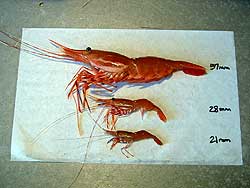
Stock assessment survey
Spot shrimp are widely distributed within the North Pacific Ocean. They occur from the intertidal to depths of greater than 1,500 feet, from the Korea Strait to the Sea of Japan, along the Siberian east coast, and from Unalaska to San Diego, California.
All pandalid shrimp are protandric hermaphrodites; they mature and spawn first as males, and subsequently transition to females and spawn as females for the remainder of their lives. Spot shrimp are thought to mature sexually after 1.5 years and to reproduce as males for one or two seasons in British Columbia
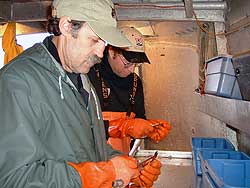
Spot shrimp, Pandalus platyceros, are targeted by a pot fishery in Southeast Alaska. A fixed quota harvest strategy is employed in managing the fishery, and data is reviewed annually to determine stock status and guideline harvest levels (GHLs). Guideline harvest levels are set within a guideline harvest range (GHR) and targeted inseason. The upper limit of GHRs were originally set based on historical harvest levels, but have since been adjusted.
A stock assessment program has been developed to support management. This includes fishery-independent pot surveys in 4 of 19 management units; Tenakee Inlet, Hoonah Sound, Ernest Sound, and Cordova Bay. Collectively these surveyed areas account for approximately 38% on average of the annual harvest of the fishery. Six to nine longlined strings of pots are set on each of four days per area. The locations of these strings are the same year to year, thus giving an annual index of shrimp abundance without spatial bias.
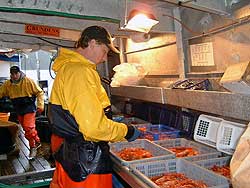
The results of the survey are combined with fishery dependant data including commercial catch sampling (both dockside and on the fishing grounds), logbooks, and fish ticket data. Statistical tests are done on catch rate (survey, logbook and commercial), shrimp size, the size at which 50% are female (L50), and on harvest rate estimates from depletion modeling of logbook. The current season's data are compared with the long term baselines, and recent year's values and scored to designate a stock status of "Good", "Above Average", "Moderate", "Below Average", "Poor", or "Unknown". A confidence rating is also determined for each stock status based on the proportion of actual to possible data pieces. These test results and scores are assessed by managers with the advice of research staff to set the GHL for the following season.
Estimation of exploitation rate
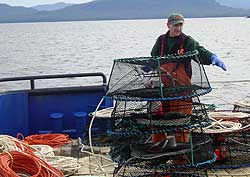
The following project summary is excerpted from Clark and Love (Clark and Love 2003):
1 Pot shrimp fisheries in Southeast Alaska harvest primarily spot shrimp, Pandalus platyceros, with generally less than 5% of the harvest comprised of other species of shrimp. Harvest levels established for these fisheries are based on averages of past historical catch records. In some areas these levels of harvest may prove unsustainable for a variety of reasons, including unrealistically large catches from virgin populations of shrimp and changes in the environmental conditions affecting shrimp survival. In other areas these levels may prove to be too low due to low levels of effort during years used to establish the harvest levels. Accurate estimates of size composition and relative abundance are necessary to evaluate current harvest levels, establish sustainable exploitation rates, and assess the abundance and stock condition of spot shrimp in key harvest areas. This project was initiated to develop, evaluate, revise, and establish stock assessment survey protocol and analytical methods to estimate size composition and relative abundance of spot shrimp in Southeast Alaska.
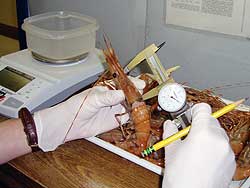
The primary objectives of this project were to develop practical, cost effective stock assessment methods to accurately measure the size composition and relative abundance of spot shrimp; and to develop and evaluate analytical methods to estimate the abundance of spot shrimp in the survey areas. Both an Alaska Department of Fish and Game vessel and commercial pot shrimp charter vessel were used in two areas to determine the feasibility of collecting accurate estimates of size composition and relative abundance of spot shrimp and the effect of soak time, mesh size, abundance and size composition of shrimp on survey catches. Index removal methods and a mesh selectivity model were developed and applied to catches from surveys conducted prior to, and immediately after, the commercial pot shrimp fishery in two areas.
Dockside sampling
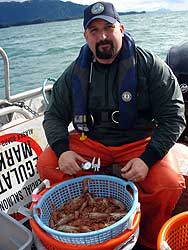
The data collected during dockside sampling are used to generate catch size frequencies, and size at sex metrics by fishing location for the commercial pot shrimp fishery. This data is used in the management plan for the fishery, and is useful for evaluating year class cohorts.
On-the-grounds sampling
While actively managing the fishery, managers take samples from commercial catches for establishing fine scale catch size frequencies, and size at sex information to assist in examining fishing pressure and setting harvest levels for the fishery.
Publications authored by ADF&G Staff or contractors
- Bishop, G., C. Siddon, and J. Bednarski. 2009. Stock Status of Spot Shrimp in Southeast Alaska Prior to the 2008–09 Season (Large PDF 15,598 kB). Alaska Department of Fish and Game, Fisheries Data Series #09-46, Douglas.
- 1 Clark, J. E., and D. C. Love. 2003. Southeast Alaska Pot Shrimp Research. Pages 39 – 57 In: Nearshore Marine Research in Alaska: Final Comprehensive Progress Report, August 1, 2000 – June 30, 2002 NOAA Cooperative Agreement #NA06FN0385: Project 4: Southeast Alaska Pot Shrimp Research, p. 39 – 57. Alaska Department of Fish and Game, Division of Commercial Fisheries, Juneau.
- Davidson, B., R. Bachman, G. Bishop, W. Bergmann, P. Doherty, D. Gordon, K. Hebert, J. Breese, K. Monagle, E. Coonradt, S. Forbes, D. Harris, B. Meredith and T. Thynes. 2005. Southeast Alaska Pot Shrimp Fishery Management Plan, 2005 (PDF 1,742 kB). Alaska Department of Fish and Game, Fishery Management Report #05-50, Anchorage.
- Love, D. C., and G. H. Bishop. 2005. Pot Shrimp Stock Assessment Survey Results from 1996-2003 in Districts 3, 7, 12, and 13 of Southeastern Alaska (PDF 563 kB). Alaska Department of Fish and Game, Fishery Data Series #05-32, Anchorage.
- Smith, Q. 2020. Southeast Alaska Pot Shrimp Stock Status Prior to the 2019/20 Season (PDF 2,476 kB). Alaska Department of Fish and Game, Fisheries Data Series #20-19, Douglas.
- Smith, Q. 2020. Southeast Pot Shrimp Stock Status Prior to the 2018/19 Season (PDF 2,476 kB). Alaska Department of Fish and Game, Fisheries Data Series #20-11, Douglas.
- Smith, Q. 2018. Southeast Pot Shrimp Stock Status Prior to the 2017/18 Season (PDF 1,909 kB). Alaska Department of Fish and Game, Fisheries Data Series #18-34, Douglas.
- Smith, Q. 2018. Operational Plan: Southeast Alaska Pot Shrimp Survey, 2018–2022 (PDF 1,435 kB kB). Alaska Department of Fish and Game, Regional Operational Plan #CF.1J.2018.07, Douglas.
![]() Adobe Acrobat PDF files require a free viewer available directly from Adobe.
Adobe Acrobat PDF files require a free viewer available directly from Adobe.
